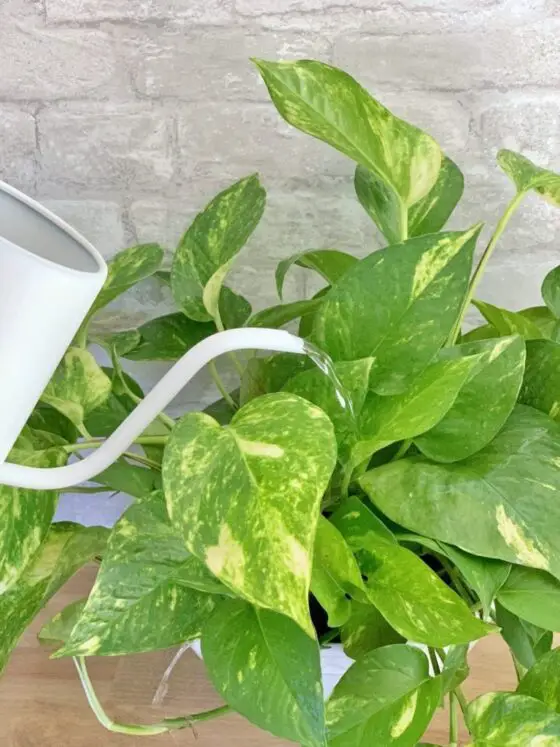Looking for answers on how often to water your pothos plant? You’ve come to the right place! Watering is a crucial aspect of pothos care, and getting it right can make all the difference in keeping your plant healthy and thriving.
In this article, we’ll delve into the ins and outs of watering your pothos, including the signs to look out for and a foolproof watering schedule. So, if you’ve been wondering how often to water pothos, keep reading to ensure your green friend gets just the right amount of hydration it needs.
Let’s dive in!
How Often to Water Pothos
Pothos, also known as Devil’s Ivy, is a popular houseplant appreciated for its lush green foliage and low-maintenance nature. Proper watering is crucial to keep your pothos healthy and thriving.
In this guide, we will explore how often to water pothos, taking into consideration factors such as the plant’s environment, potting mix, and signs of under or overwatering.
Read More: About How Often To Water Kangaroo Fern? A Comprehensive Guide
Understanding Pothos Watering Needs
Before diving into the specifics of watering frequency, it’s important to understand the natural habitat and water requirements of pothos plants. Pothos is native to tropical rainforests, where abundant rainfall and high humidity are prevalent.
Replicating this environment to some extent is key to providing optimal conditions for your pothos.
Finding the Right Balance
When it comes to watering pothos, finding the right balance is crucial. Overwatering can lead to root rot and other issues, while underwatering can cause the plant to wilt and suffer.
The goal is to keep the soil consistently moist, but not waterlogged.
Factors Affecting Watering Frequency
Several factors influence how often you should water your pothos. These include:
- Climate and Season:
Pothos plants require less water during cooler months and more frequent watering during warmer months. Adjust your watering schedule accordingly.
- Humidity:
Pothos plants enjoy higher humidity levels. If your home has low humidity, consider using a humidifier or placing a tray of water near the plant to increase moisture in the air.
- Pot Size:
The size of the pot also affects watering frequency. Smaller pots dry out more quickly, requiring more frequent watering.
- Potting Mix:
Well-draining potting mix is essential for pothos. If the mix retains too much water, it can lead to waterlogged roots. A mix containing peat moss, perlite, and vermiculite or a commercial potting mix designed for houseplants is ideal.
- Exposure to Light:
Pothos plants thrive in bright, indirect light. If your plant receives more intense light, it may require more frequent watering to compensate for increased evaporation.
Signs of Underwatering and Overwatering
Recognizing the signs of underwatering and overwatering is crucial to adjust your watering frequency accordingly. Here are some indicators to look out for:
Underwatering
- Wilted leaves:
If the leaves of your pothos appear droopy and are losing their turgidity, it may be a sign of underwatering.
- Dry soil:
Check the moisture level of the soil by sticking your finger about an inch deep. If it feels dry, it’s time to water.
- Yellowing leaves:
Leaves turning yellow and becoming crispy can indicate prolonged underwatering.
Overwatering
- Yellowing leaves:
While underwatering can also cause yellowing, overwatering is often accompanied by soggy, mushy leaves.
- Rotting roots:
Overwatering can lead to root rot, which is characterized by a foul smell and black, mushy roots.
- Mold or fungus growth:
Excessive moisture in the potting mix can create an ideal environment for mold and fungus to thrive.
Watering Guidelines for Pothos
To provide the ideal watering conditions for your pothos, follow these general guidelines:
1. Assess the Moisture Level
Check the moisture level of the potting mix by inserting your finger about an inch deep into the soil. If it feels slightly moist, your pothos is likely adequately hydrated. If the soil feels dry, it’s time to water.
2. Water Thoroughly
When watering, ensure that the entire root ball gets adequately moistened. Water until you see it draining out from the bottom of the pot. This ensures that the water reaches the roots and helps flush out any built-up salts in the soil.
3. Allow Proper Drainage
Make sure your pothos is planted in a pot with drainage holes. This allows excess water to escape, preventing waterlogged roots. If your pot doesn’t have drainage holes, consider transferring your plant to a suitable container.
4. Observe and Adjust
Pay attention to how your pothos responds to watering. If the leaves start to wilt, increase the frequency of watering. If you notice signs of overwatering, such as yellowing leaves and root rot, reduce the watering frequency.
Each plant’s needs may vary slightly, so it’s important to observe and adjust accordingly.
5. Consider Using Self-Watering Methods
If you often find it challenging to maintain consistent watering habits or if you frequently travel, you may want to consider self-watering methods. Self-watering pots or using a water-absorbing device can help regulate moisture levels and ensure your pothos receives water as needed.
Proper watering is crucial for the health of your pothos plant. By understanding the plant’s natural habitat, considering environmental factors, and observing signs of under or overwatering, you can determine the ideal watering frequency.
Remember to find the right balance, provide adequate drainage, and adjust your watering practices as necessary. With proper care, your pothos will thrive and bring beauty to your indoor space.
Read More: About Dirt Locker Alternative: A Game-Changing Solution For Storage
Frequently Asked Questions (FAQs)
Pothos plants prefer slightly moist soil, so it is best to water them when the top inch of soil feels dry. Depending on the temperature and humidity levels in your home, this usually translates to watering your pothos every 1-2 weeks.
Yes, overwatering can be detrimental to pothos plants. It is important to avoid leaving your pothos sitting in water, as this can lead to root rot. Make sure to allow the excess water to drain out of the pot before placing it back in its saucer or decorative container.
You can check if your pothos plant needs watering by inserting your finger into the soil up to the second knuckle. If it feels dry at that depth, it’s time to water your plant. Additionally, drooping leaves or a lighter color of the leaves can indicate that your pothos needs water.
The best method for watering a pothos is to thoroughly drench the soil until water starts to come out of the drainage holes. Allow the excess water to drain out completely before returning the plant to its usual spot. Avoid misting the leaves as this can encourage fungal diseases.
Underwatering can cause the leaves of a pothos plant to wilt and turn yellow. Additionally, the growth of the plant may slow down, and the leaves might become brittle or dry. It is important to find the right balance and provide enough water for your pothos to thrive.
Tap water can be used for watering pothos plants, but it is important to let the water sit for at least 24 hours before using it. This allows any chlorine or fluoride present in the tap water to dissipate, as these chemicals can be harmful to the plant over time.
Misting is not necessary for pothos plants. In fact, it is best to avoid misting as it can create a humid environment that favors the growth of fungal diseases. Focus on providing adequate water to the soil instead.
Yellowing leaves in a pothos plant can be a sign of overwatering, underwatering, or poor drainage. Check the moisture level in the soil and adjust your watering schedule accordingly. Ensure that the pot has proper drainage holes and consider repotting if necessary.
Final Thoughts
Knowing how often to water your pothos is essential for maintaining its health and vibrant appearance. The frequency of watering largely depends on various factors, such as the size of the plant, environmental conditions, and potting medium. Generally, it is recommended to wait until the top inch of soil feels dry before watering your pothos.
This ensures that you are not overwatering, which can lead to root rot, while also preventing the plant from becoming too dry. Keep a close eye on your pothos and adjust the watering schedule accordingly to ensure optimal growth and vitality.
Auto Amazon Links: No products found.
Perfect Plants Christmas Tree Saver 8oz. | Easy Use Xmas Tree Preserver Food | Have Healthy Green Christmas Trees All Holiday Season
$9.97 (as of December 16, 2025 05:22 GMT +00:00 - More info- Product prices and availability are accurate as of the date/time indicated and are subject to change. Any price and availability information displayed on [relevant Amazon Site(s), as applicable] at the time of purchase will apply to the purchase of this product.
FirEver Pure Christmas Tree Food | Preserver Additive & Season Extender for Live Xmas Trees | Keep It Green, Reduce Needle-Drop | Miracle Freshness (8 oz)
$14.99 (as of December 16, 2025 05:22 GMT +00:00 - More info- Product prices and availability are accurate as of the date/time indicated and are subject to change. Any price and availability information displayed on [relevant Amazon Site(s), as applicable] at the time of purchase will apply to the purchase of this product.
Rocky Mountain Goods Christmas Tree Food - 8 oz Tree Preservative - Reduce Needle Drop - Greener Scent - Fir, Pine, Spruce Trees - Extend Tree Life
$9.95 (as of December 16, 2025 05:22 GMT +00:00 - More info- Product prices and availability are accurate as of the date/time indicated and are subject to change. Any price and availability information displayed on [relevant Amazon Site(s), as applicable] at the time of purchase will apply to the purchase of this product.
EZMeetU Christmas Tree Watering Funnel, 47 Inch Flower Shape Adjustable 6 Section Design, Christmas Tree Watering System, Christmas Tree Waterer, Long Funnel Wide Opening Reusable, Plant Watering Tool
$16.99 (as of December 16, 2025 05:22 GMT +00:00 - More info- Product prices and availability are accurate as of the date/time indicated and are subject to change. Any price and availability information displayed on [relevant Amazon Site(s), as applicable] at the time of purchase will apply to the purchase of this product.
VICAMB 39.3 Inch Christmas Tree Watering Funnel,Christmas Tree Watering System Device,Long Tree Watering Funnel Spout for Indoor Outdoor Xmas Tree
$17.99 (as of December 16, 2025 05:22 GMT +00:00 - More info- Product prices and availability are accurate as of the date/time indicated and are subject to change. Any price and availability information displayed on [relevant Amazon Site(s), as applicable] at the time of purchase will apply to the purchase of this product.
Snow Joe Premium Enviro Blend Ice Melt, Green-Coated Deicer Crystals, 50 lb - Safer Melter for Vegetation, Concrete & Metals w/ Anti-Corrosion Calcium Magnesium Acetate
$32.97 (as of December 12, 2025 19:27 GMT +00:00 - More info- Product prices and availability are accurate as of the date/time indicated and are subject to change. Any price and availability information displayed on [relevant Amazon Site(s), as applicable] at the time of purchase will apply to the purchase of this product.
Muddy Mat® Shown on TV Super Absorbent Microfiber Dog Door Mat for Muddy Paws, Non-Slip Washable Pet Rug, Quick Dry Chenille Entryway Carpet, Machine Washable Indoor Outdoor mat, Grey 30"x19"
$24.95 (as of December 12, 2025 19:27 GMT +00:00 - More info- Product prices and availability are accurate as of the date/time indicated and are subject to change. Any price and availability information displayed on [relevant Amazon Site(s), as applicable] at the time of purchase will apply to the purchase of this product.
ivtivfu Rolling Grill Basket, Removable Wooden Handle, 304 Stainless Steel, Nesting BBQ Tools, Smoker Grilling Accessories for Vegetable, Outdoor Cooking Camping, Birthday Gifts for Men Dad Husband
$25.99 (as of December 12, 2025 19:27 GMT +00:00 - More info- Product prices and availability are accurate as of the date/time indicated and are subject to change. Any price and availability information displayed on [relevant Amazon Site(s), as applicable] at the time of purchase will apply to the purchase of this product.
XXXFLOWER Plant Terrarium with Wooden Stand, Air Planter Bulb Glass Vase Metal Swivel Holder Retro Tabletop for Hydroponics Home Garden Office Decoration - 3 Bulb Vase
$18.98 (as of December 12, 2025 19:27 GMT +00:00 - More info- Product prices and availability are accurate as of the date/time indicated and are subject to change. Any price and availability information displayed on [relevant Amazon Site(s), as applicable] at the time of purchase will apply to the purchase of this product.
Zevo Flying Insect Trap Official Refill Cartridges - Fits Both Zevo Trap & MAX Indoor Fly Trap - Authentic Trap+Lock Technology to Catch Gnats, House & Fruit Flys (4 Official Refill Cartridges)
$14.97 (as of December 12, 2025 19:27 GMT +00:00 - More info- Product prices and availability are accurate as of the date/time indicated and are subject to change. Any price and availability information displayed on [relevant Amazon Site(s), as applicable] at the time of purchase will apply to the purchase of this product.











